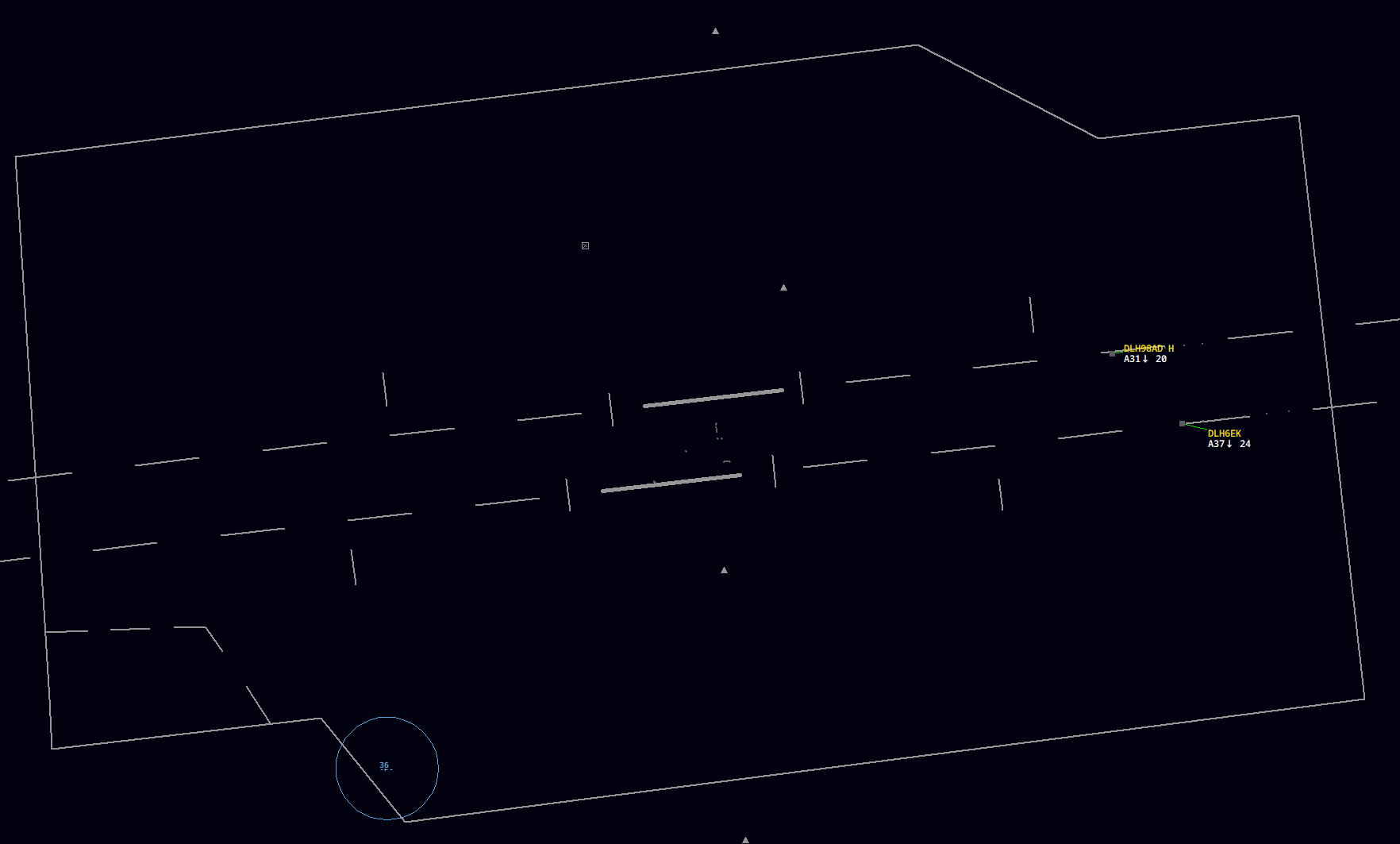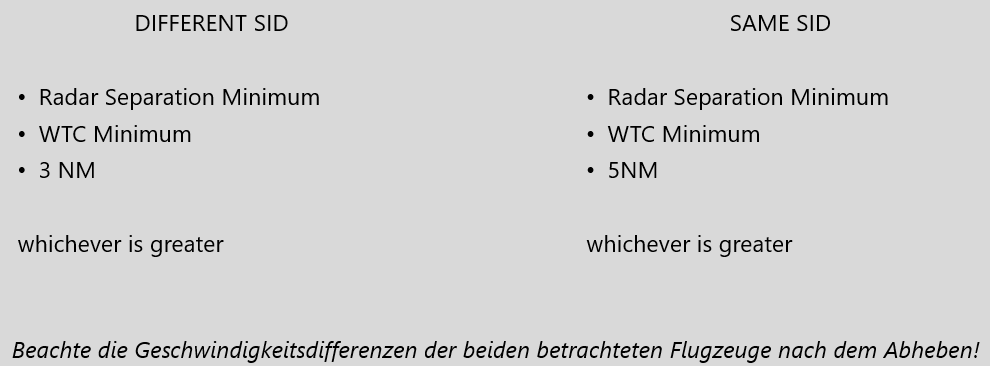Tower Separation
General
All control towers operated by DFS (German Air Traffic Control) at international airports (EDDx) have a radar system that can provide radar separation. This might sound obvious at first glance, but it is not. There are still some controlled airports in Germany, such as Mannheim or Karlsruhe, which either do not have radar or whose air traffic control personnel are not trained to use radar for separation. At these airfields, the conventional approach is separated through timing or the separation between IFR arrivals and departures is delegated to the radar controller above.
Here you can see an example of the air situation radar at Munich Airport (click for full screen):
Here you can see the lateral boundaries of the Munich control zone, you can see the two runways in the middle and dashed lines in their extension, the so-called extended centerlines. Each gap and dash on this extended centerline equals one mile. Among other things, this enables us to measure distances in the control zone and therefore use the radar to create separation. On the final approach to runways 26L and 26R, you can see two radar targets representing two aircraft. Next to the actual radar target you see the so-called label or tag. These two terms describe the information (here: callsign, groundspeed and altitude) provided to the controller by the radar system.
The basic minimum radar separation is 5 NM. With appropriate radar technology, this separation may be reduced to 3 NM. In Germany, radar coverage has become good good enough to allow us to operate at 3 NM separation almost everywhere (with a few exceptions in the Bremen FIR and in the very south over the Alps) below FL245. Consequently, 3 NM is also the minimum value in your control zone if you have to use radar separation there.
Between which flights do we have to ensure radar separation? To do this, we need to know which airspace class we are in. In the table in the airspaces chapter, the third column of the table shows us who must be separated from whom. In your airspace as a tower controller, i.e. D-CTR, you only need to separate IFR flights*. For example, if a VFR flight approaches an IFR flight at the same altitude to within 1 NM, this is not a "rule violation" in D-CTR. In airspace class C, on the other hand, this would be a "rule violation", as there (as you can see in the table) IFR must also be separated from VFR. This means that the approach controller in airspace C must make sure that every VFR flight is at least 3 NM away from any IFR flight. However, since you are a tower controller in charge of a D-CTR, this is very convenient for you. These "rule violations" connected to separation are called “loss of separation” or LOS (STU or STaffelungsUnterschreitung in German). These LOSes must be prevented at all costs, as they are safety-critical events and usually lead to a failing grade in a practical test on VATSIM.
*In the 2 training you will also learn that IFR to SVFR (special VFR) must also be separated in the control zone. More information on this in this and this article. However, this is not yet mandatory for S1 training so as not to make it too complex.
Departures
As a tower controller you are responsible for the take-off sequence and the spacing between take-offs. It will take a while before you develop a feeling for how long you need to wait between two departures to achieve a desired separation.
If you have to separate two departures, you must select the largest value between
- Radar separation (always 3 NM)
- Wake turbulence separation (4 - 8 NM)
- Departure Spacing (individual value)
Radar separation, therefore, always is the minimum between two IFR aircraft. Depending on the constellation of wake turbulence categories you may also have to keep wake turbulence separation. Details on these values can be found in the corresponding article.
But what is departure spacing? Sometimes local procedures require more spacing than separation actually prescribes. One example is departures on the same SIDs:
An additional requirement for departure spacing most airports require a minimum spacing between consecutive departures on the same SID of least 5 NM (see your training airport's SOP for details).
While separation always describes the absolute minimum, spacing is a value that is always at least equal to or greater than the separation minimum and includes an optional safety margin.
In mathematical terms: Spacing = separation minimum + optional safety margin.
The approach or center controller may also specify a departure spacing in individual cases if the airspace is very full. An MDI, i.e. Minimum Departure Interval, usually expressed in minutes, can also be imposed here. With the restriction "MDI CINDY 5 minutes", for example, the tower controller may allow departures to waypoint CINDY only with an interval of at least 5 minutes.
To summarize, here is a short workflow that quickly and easily provides you with the correct minimum distance between two departures. Ideally and in the spirit of proactive controlling, you should not wait until the two aircraft concerned are already at the holding point to go through this flow. Do it as early as possible. Example: I give two pilots a clearance for pushback at the same time and already simultaneously consider what departure spacing will later be required on the runway. Everything that has already been planned only needs to be put into action and you have capacity for other things.
If your aircraft are on different SIDs, move to the left half of the table and go through the three bullet points: Radar Separation is always 3NM (on both sides). The largest value of the three bullet points is your minimum departure spacing.
You now know which constellation commands how much separation. But when can you give the takeoff clearance to the rear pilot in two takeoffs? When the required separation is achieved? No, earlier than that, because the radar or wake turbulence separation must be ensured at the time when the following aircraft goes airborne. However, since the front aircraft also covers a certain distance between the issuance of the takeoff clearance and the takeoff of the following aircraft, you can issue the takeoff clearance earlier. As a rule of thumb for average airliners, you can say that takeoff clearance may be given about 0,5 NM - 1 NM before the required separation. So if you need 3 NM, you can give the takeoff clearance at 2 NM - 2,5 NM. For a 4 km long runway, this corresponds to just under the end of the runway.

DLH3TK has reached the end of the runway and ACA841 receives the takeoff clearance; the distance is 2.1 NM, just under 1 NM less than the required separation

Result: The aircraft go airborne with a distance just over 3 NM - optimum separation
IMPORTANT: Always bear in mind the different speeds on take-off. If you have a C172 lead an A380 on a different SID, you could theoretically separate them by 3 NM. It should be logical that this does not make sense, as the A380 flies at least twice as fast as the Cessna and therefore, at a 3NM separation a LOS will definitely occur shortly after takeoff.
In such cases (following departure significantly faster than leading departure), it is advisable to flip the departure sequence and let the fast traffic take off as number 1. See also the article Tower Efficiency. If this is not possible and you have to send a fast departure out after a slow approach, coordinate the timing of the departure with Approach. They have the option of solving the problem by tactically using vectors or different altitudes and should let you know when you can send the fast departure on its way.
You should also pay attention to the initial rate of climb of the leading departure for "normal" airliners. Especially on the network, there are pilots who fly unrealistically fast or slow.
In general, if you are not sure about something, always ask. Especially the colleagues on APP and CTR usually have more experience and will be happy to help you
Inbounds
The handling of approaches for you as a tower controller can be explained quickly. You receive approaching aircraft from the approach controller approximately 8 - 12 NM before the runway. If you have approaching traffic on your frequency, you should give them clearance to land as quickly as possible. If you receive an approach and you have no departing traffic, you should give them clearance to land directly with the initial call. A pilot must have their landing clearance at the latest before crossing the runway threshold. If they don’t have clearance then, they will go around on their own.
The approach controller is responsible for the separation between approaches until the runway threshold is crossed. At international airports (EDDx), however, you as the tower controller may "save" the separation with the help of speed restrictions if you notice that without them, a LOS would become probable. You can also use speed instructions to maintain a gap for a VFR pilot, for example. However, it is important to coordinate speed instructions with the approach controller if there is another aircraft behind the aircraft with the assigned speed.
If two approaches are so close that there is still a risk of a loss of separation, you must instruct one of the aircraft (usually the following one) to go around before(!) the loss of separation occurs. In addition, traffic information about the traffic concerned can be useful. Further information on handling missed approaches can be found in the corresponding chapter.


